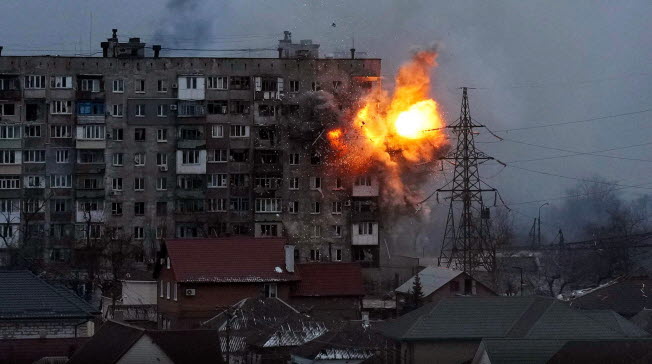Ukrainian documentary “20 Days in Mariupol”, which received the Audience Award at the World Cinema Documentary Competition of the Sundance Film Festival early in this year, is a vivid and disturbing presentation of the first 20 days of one Ukrainian city under siege around the beginning of Russian Invasion of Ukraine in last year. As closely observing many palpable moments of fear and desperation, it gives us a very close look into the ongoing war, and, as said at one point early in the documentary, it will be probably remembered more as an important record of one of the darkest historical moments of Ukraine and its people.
Right from the beginning, director/producer Mstylave Chernov, who also shot his documentary with Evgeniy Maloetka, puts us right into the middle of that grim situation surrounding Mariupol in February 2022. As Russia and its despicable dictator begin the invasion into the Eastern part of Ukraine, Mariupol became one of the primary targets to attack, and the city and its citizens soon found themselves nearly isolated from the world outside as the Russian Army surrounded the city step by step.
Nevertheless, Chernov and a number of colleagues of his kept recording and reporting on what was going in Mariupol as the city was thrown into more dread and confusion. While not only electricity but also heat and communication were cut off, the city was frequently attacked by the Russian Air Force, and those disturbing sounds of the approaching front lines became louder day by day while millions of citizens were thrown into more and more danger.
As a consequence, a number of hospitals in the city were quite busy with handling the civilian casualties of the war everyday, and the documentary strikes us hard with a series of devastating moments you will not easily forget. We see those valiant emergency workers and hospital employees diligently working everyday even though their strenuous efforts are often limited by the war as well as the resulting lack of resources such as painkillers. We see many different injured people taken to hospital, some of them sadly could not be saved no matter how much doctors and nurses tried. At one point, one of the doctors cannot help but become quite emotional about the war and those people responsible for it, and that is heartbreaking to watch to say the least.
The documentary wisely limits itself within its relatively small background. As what was shot by Chernov and his colleagues is occasionally shown on the American TV news channels, we get some background information on what was happening during the first several days of the war, and that is more enough for us to sense and understand how is getting for Mariupol and its citizen. As the documentary continues to show more of the close observation of the city and its citizens under attack, we become more immersed into their utterly dreadful circumstance, and we reflect more on how they desperately hoped for the eventual end of the siege on the city.
And the documentary becomes gloomier as showing the growing number of civilian casualties caused by the increasing attacks from the Russian Army. Right after one of the big hospitals in the city was heavily attacked, Chernov and his colleagues immediately went there, and what was captured on their cameras is another devastating moment in the documentary. In case of one certain injured pregnant woman, her condition looked quite serious, so Chernov subsequently tried to track down her, but he only faced another sad consequence of the war.
We also look at several volunteers handling a bunch of dead bodies containing in individual bags, and one of these volunteers is understandably reluctant to express his feelings and thoughts in front of the camera. While looking phlegmatic on the surface, he is barely holding himself after witnessing so much from his grim job, and we come to reflect more on the cruelty of war.
In the meantime, the city became invaded much more by the Russian Army, and that was when Chernov and his colleagues began to consider leaving the city for their safety. As they were about to leave the city, they saw more soldiers around them, and they even found themselves seriously threatened by those Russian snipers and tanks at one point later in the documentary. It was clear to everyone in the city that the end was near, and Chernov and his colleagues eventually left the city along with their video records and their families when they were allowed to evacuate a few days later.
On the whole, “20 Days in Mariupol”, which was recently selected as the Ukrainian submission to Best International Film Oscar, is surely a tough and difficult stuff which will often chill and horrify you for the sheer horror and despair inside it, but it is worthwhile to watch for many powerful moments delivered via its unflinching approach to its main subject. While mostly staying behind the cameras and occasionally providing some musing of his via his calm and restrained narration, Chernov, who deservedly received the Pulitzer Prize for Public Service for his reporting on the siege early in this year, wisely lets the rough but undeniably visceral images of the documentary speak for themselves, and your mind will be haunted by these images more and more after watching it. In short, this is one of the more impressive documentaries of this year, and I think you should check it out as soon as possible.











Pingback: 10 movies of 2023 – and more: Part 2 | Seongyong's Private Place
Pingback: My Prediction on the 96th Academy Awards | Seongyong's Private Place